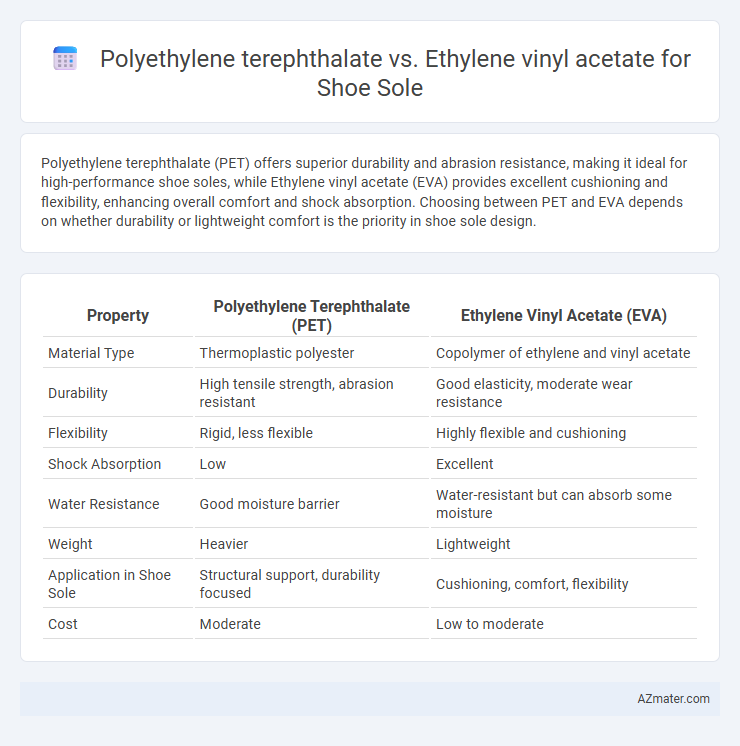Polyethylene terephthalate (PET) offers superior durability and abrasion resistance, making it ideal for high-performance shoe soles, while Ethylene vinyl acetate (EVA) provides excellent cushioning and flexibility, enhancing overall comfort and shock absorption. Choosing between PET and EVA depends on whether durability or lightweight comfort is the priority in shoe sole design.
Table of Comparison
| Property | Polyethylene Terephthalate (PET) | Ethylene Vinyl Acetate (EVA) |
|---|---|---|
| Material Type | Thermoplastic polyester | Copolymer of ethylene and vinyl acetate |
| Durability | High tensile strength, abrasion resistant | Good elasticity, moderate wear resistance |
| Flexibility | Rigid, less flexible | Highly flexible and cushioning |
| Shock Absorption | Low | Excellent |
| Water Resistance | Good moisture barrier | Water-resistant but can absorb some moisture |
| Weight | Heavier | Lightweight |
| Application in Shoe Sole | Structural support, durability focused | Cushioning, comfort, flexibility |
| Cost | Moderate | Low to moderate |
Introduction to Shoe Sole Materials
Polyethylene terephthalate (PET) and Ethylene vinyl acetate (EVA) are widely used materials in shoe sole manufacturing due to their distinct properties. PET offers excellent durability, chemical resistance, and dimensional stability, making it ideal for rigid and supportive soles. EVA provides superior cushioning, flexibility, and shock absorption, favored in athletic and casual footwear for enhanced comfort and lightweight performance.
Overview of Polyethylene Terephthalate (PET)
Polyethylene Terephthalate (PET) is a thermoplastic polymer known for its strength, durability, and excellent resistance to abrasion and impact, making it suitable for shoe sole applications that demand longevity and wear resistance. PET offers high tensile strength and dimensional stability, contributing to superior structural support in footwear compared to Ethylene Vinyl Acetate (EVA), which is softer and more flexible but less durable. Its moisture resistance and recyclability also position PET as an environmentally favorable choice within sustainable shoe sole manufacturing.
Overview of Ethylene Vinyl Acetate (EVA)
Ethylene Vinyl Acetate (EVA) is a lightweight, flexible polymer widely used in shoe soles for its superior cushioning, shock absorption, and durability compared to Polyethylene Terephthalate (PET). EVA offers excellent resistance to cracking and UV radiation, enhancing the comfort and longevity of footwear, especially in athletic and casual shoes. Its ability to maintain softness at low temperatures makes EVA a preferred material in various shoe sole applications requiring flexibility and impact resistance.
Physical and Mechanical Properties Comparison
Polyethylene terephthalate (PET) offers high tensile strength, superior dimensional stability, and good abrasion resistance, making it ideal for durable shoe soles requiring structural integrity. Ethylene vinyl acetate (EVA) exhibits excellent flexibility, shock absorption, and lightweight cushioning properties, which enhance comfort and reduce fatigue in athletic footwear. While PET is more rigid and resistant to deformation, EVA provides better elasticity and cushioning, catering to different performance needs in shoe sole applications.
Cushioning and Comfort Analysis
Polyethylene terephthalate (PET) offers high durability and structural rigidity for shoe soles but provides limited cushioning compared to ethylene vinyl acetate (EVA), which excels in shock absorption and flexibility. EVA's molecular structure allows for superior energy return and softness, enhancing overall comfort during prolonged wear. PET's rigidity makes it suitable for stability-focused soles, while EVA's lightweight and cushioning properties deliver optimal comfort for athletic and casual footwear applications.
Durability and Wear Resistance
Polyethylene terephthalate (PET) offers superior durability and wear resistance for shoe soles due to its high tensile strength and dimensional stability, making it ideal for long-lasting footwear applications. Ethylene vinyl acetate (EVA) provides excellent cushioning and flexibility but generally exhibits lower abrasion resistance and can degrade faster under heavy wear conditions. Choosing PET enhances sole longevity in rugged environments, whereas EVA suits lighter, comfort-focused designs.
Environmental Impact and Recyclability
Polyethylene terephthalate (PET) offers superior recyclability due to its widespread collection systems and established recycling infrastructure, making it a more environmentally sustainable option for shoe soles compared to ethylene vinyl acetate (EVA). EVA, while lightweight and flexible, poses greater challenges in recycling due to its mixed polymer composition and limited recycling facilities, often resulting in landfill disposal and increased environmental impact. Choosing PET for shoe soles supports circular economy practices by reducing plastic waste and energy consumption during production and recycling.
Cost and Manufacturing Considerations
Polyethylene terephthalate (PET) offers cost-effective production benefits due to its widespread availability and recyclability, making it a popular choice for shoe soles in mass manufacturing. Ethylene vinyl acetate (EVA) incurs higher raw material costs but provides enhanced flexibility and cushioning, often justifying its use in performance and comfort-focused footwear. Manufacturing PET soles typically involves more energy-intensive processes, whereas EVA allows for simpler molding techniques, reducing labor and tooling expenses.
Application Suitability for Different Footwear Types
Polyethylene terephthalate (PET) offers excellent durability, rigidity, and moisture resistance, making it ideal for high-performance athletic shoes and hiking boots requiring strong structural support. Ethylene vinyl acetate (EVA) provides superior cushioning, flexibility, and shock absorption, which suits casual footwear, running shoes, and children's sneakers focused on comfort and lightweight wear. Selecting between PET and EVA for shoe soles depends on the specific footwear application, balancing performance needs such as impact resistance versus everyday comfort.
Conclusion: Choosing the Right Material for Shoe Soles
Polyethylene terephthalate (PET) offers excellent durability, chemical resistance, and recyclability, making it ideal for high-performance shoe soles requiring longevity and environmental considerations. Ethylene vinyl acetate (EVA) excels in flexibility, lightweight cushioning, and shock absorption, providing superior comfort and impact protection for athletic and casual footwear. Selecting the right material depends on the specific shoe application, balancing durability needs with comfort requirements and sustainability goals.

Infographic: Polyethylene terephthalate vs Ethylene vinyl acetate for Shoe Sole
 azmater.com
azmater.com